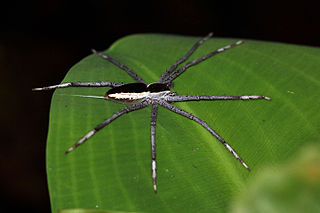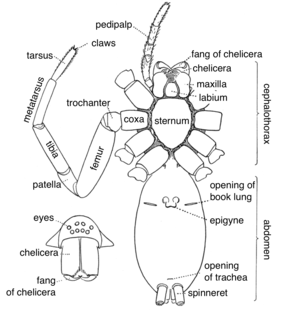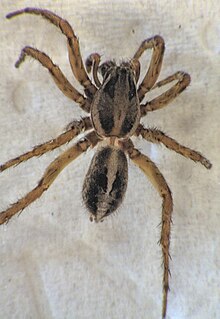
Wolf spiders are members of the family Lycosidae. They are robust and agile hunters with excellent eyesight. They live mostly in solitude, hunt alone, and do not spin webs. Some are opportunistic hunters, pouncing upon prey as they find it or chasing it over short distances; others wait for passing prey in or near the mouth of a burrow.

Nursery web spiders (Pisauridae) is a family of araneomorph spiders first described by Eugène Simon in 1890. They resemble wolf spiders (Lycosidae) except for several key differences. Wolf spiders have two very prominent eyes in addition to the other six, while a nursery web spider's eyes are all about the same size. Additionally, female nursery web spiders carry their egg sacs with their jaws and pedipalps instead of attaching them to their spinnerets as wolf spiders do. When the eggs are about to hatch, a female spider builds a nursery "tent", places her egg sac inside, and stands guard outside, hence the family's common name. Like the wolf spiders, however, the nursery web spiders are roaming hunters that don't use webs for catching prey.

The epigyne or epigynum is the external genital structure of female spiders. As the epigyne varies greatly in form in different species, even in closely related ones, it often provides the most distinctive characteristic for recognizing species. It consists of a small, hardened portion of the exoskeleton located on the underside of the abdomen, in front of the epigastric furrow and between the epigastric plates.

Tord Tamerlan Teodor Thorell was a Swedish arachnologist.

The Artoriinae are a subfamily of wolf spiders. The monophyly of the subfamily has been confirmed in a molecular phylogenetic study, although the relationships among the subfamilies was shown to be less certain.

The book Svenska Spindlar or Aranei Svecici is one of the major works of the Swedish arachnologist and entomologist Carl Alexander Clerck and was first published in Stockholm in the year 1757. It was the first comprehensive book on the spiders of Sweden and one of the first regional monographs of a group of animals worldwide. The full title of the work is Svenska Spindlar uti sina hufvud-slägter indelte samt under några och sextio särskildte arter beskrefne och med illuminerade figurer uplyste – Aranei Svecici, descriptionibus et figuris æneis illustrati, ad genera subalterna redacti, speciebus ultra LX determinati, and included 162 pages of text and six colour plates. It was published in Swedish, with a Latin translation printed in a slightly smaller font below the Swedish text.

Pirata is a genus of wolf spiders, commonly known as pirate wolf spiders.

Trebacosa is a genus of wolf spiders first described by Dondale & Redner in 1981.

Arkyidae is a family of araneomorph spiders first described by Ludwig Carl Christian Koch in 1872 as a subfamily of Araneidae, and later elevated to a full family in 2017.
Anomalomma is a genus of spiders in the family Lycosidae. It was first described in 1890 by Simon. As of 2017, it contains 3 species.

Geolycosa is a genus of wolf spiders first described in 1904.
Lycosella is a genus of spiders in the family Lycosidae. It was first described in 1890 by Thorell. As of 2017, it contains 5 species found in Hawaii and Sumatra.
Lysania is a genus of spiders in the family Lycosidae. It was first described in 1890 by Thorell. As of 2017, it contains 4 Asian species.
Passiena is a genus of spiders in the family Lycosidae. It was first described in 1890 by Thorell. As of 2017, it contains 4 species.
Pirata aspirans is a species of wolf spider in the family Lycosidae. It is found in the United States and Canada.
Pirata montanoides is a species of wolf spider in the family Lycosidae. It is found in the United States.
Pirata sedentarius is a species of wolf spider in the family Lycosidae. It is found in North America and Greater Antilles.
Pirata alachuus is a species of wolf spider in the family Lycosidae. It is found in the United States.

Pirata piraticus is a species of wolf spider in the family Lycosidae. It is found in North America, Europe, Turkey, Caucasus, a range from Russia, Central Asia, China, and Japan.
Halocosa is a genus of wolf spiders first described by G. N. Azarkina and L. A. Trilikauskas in 2019. As of December 2021 it contains only three species: H. cereipes, H. hatanensis, and H. jartica. The type species, Halocosa cereipes, was originally described under the name "Lycosa cereipes".











